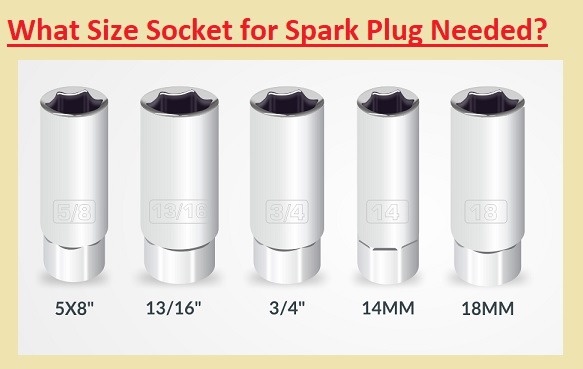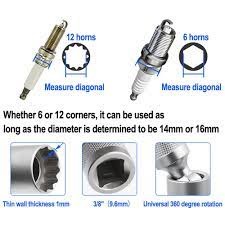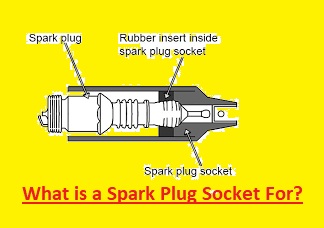Hello readers, welcome to the new post. Here, we will discuss What Size Socket for Spark Plug Needed. 2023 Complete Guide. If you are a car driver and lover, you must have seen apart plugs at some points. With time, they gets worn and have to changed to have good engine function. But do you know what size socket for spark plug replacement is needed? This post will cover the details of selecting the right socket size for changing spark plugs. So, let’s start with what size socket is a spark plug.
Introduction
Spark plugs are the main component of an internal combustion engine and have the spark required for the ignition air-fuel mixture. For changes, we required the correct socket size to ensure a smooth and effective process.
Why Spark Plug Socket Size Matters
Use the correct spark plug size for accurate replacement. The small socket does not accurately fit, and a large can damage the plug. It is good to have an accurate-size socket with a spark plug to reduce damage.
Determining the Right Socket Size
Normally used spark plug socket sizes are 5/8 inch (16mm) and 13/16 inch (21mm). To find the accurate size, use these rules.
- Read details in the vehicle datasheet.
- Read spare plug reference data
- Use spark plug socket size devices
Tools and Materials You’ll Need
These tools are needed
- Spark plug socket
- Ratchet wrench
- Anti-seize compound
- Extension bar
- Gap gauge
Step-by-Step Guide to Changing Spark Plugs
- Get the required tools and materials before starting the process
- Find the spark plug in the engine
- Remove the older spark plug with the use of a socket and wrench
- Connect the new spark plug accurately and ensure it is tightened accuralty
- Again check the is all connections are accuralty made and strong
Signs of Worn-Out Spark Plugs
- Rough idling
- Poor fuel efficiency
- Difficulty starting the engine
What is a Spark Plug Socket?
The spark plug socket is made to remove and replace spark plugs. It is deep enough to handle a spark plug and comes with a flexible sleeve to grip the spark plug and allow single-handed work. Differnt types of spark plugs are used.
What is a Spark Plug Socket For?
These sockets come with rubber isolators intended to absorb any vibration within and protect the glass featured with the spark plugs. Regular sockets do not come with rubber features, and use of them can result in breakage if attempting to spark plug change.
Two Types of Spark Plug Sockets
There are 2 main types of spark plug sockets.
- Rubber Insert Spark Plug Socket:
- This socket has a rubber insert that conforms to the shape of the spark plug. It provides a strong grip and reduces the chance of damaging the spark plug ceramic insulator.
- Magnetic Spark Plug Socket:
- it has a magnet embedded in the socket wall. The agent hols plug correctly in position helps easy removal from closed areas.
What Are The Common Sizes Of A Spark Plug Socket?
The common spark plug sizes are 5/8 inch and 13/16 inch sockets.
Spark Plug Socket Chart
| Spark Plug Size (inches) | Spark Plug Size (mm) | Socket Size (inches) | Use case |
| 7/8 | 22 | 7/8 | Not common |
| 13/16 | 20 | 13/16 | Cars |
| 3/4 | 19 | 3/4 | Small Engines |
| 11/16 | 18 | 11/16 | Old BMWs |
| 5/8 | 16 | 5/8 (16mm) | Ubiquitous (Scooters, Motorcycles, Cars) |
| 9/16 | 14 | 9/16 | Asian Cars and Some Ford Cars |
Steps on Using Spark Plug Socket for Auto Repairs
The use of a spark plug socket for auto repairs comes with these points
- Get required instruments
- Make engine cold
- Disconnect battery
- Remove Spark-Plug Wires
- Disconnect Spark Plug With the Socket.
- Check the Spark Plug.
- Connect New Spark Plug
- Reconnect Wires / Coil-On-Plug Connectors / Battery.
Top 7 Best Spark Plug Socket
Here are highly recommended spark plug sockets that can be used for your automotive tool collection:
| Feature | GEARWRENCH | Powerbuilt | ARES | LEXIVON | Apex Tool Group | Neiko |
|---|---|---|---|---|---|---|
| 5/8″ spark plug socket | Yes | Yes | Yes | Yes | Yes | Yes |
| 3/8″ drive | Yes | Yes | Yes | Yes | Yes | Yes |
| All-in-one extension and swivel joint | Yes | No | Yes | No | No | No |
| Interior magnet | Yes | No | Yes | Yes | Yes | Yes |
| Knurled grip | Yes | No | Yes | Yes | Yes | Yes |
Ignition System in Cars
A car ignition system is the main parameter for starting the internal combustion engine. Its main work is to ignite the air-fuel mixture in the engine cylinder accurately to start the combustion process, producing the power needed to propel the vehicle.
The basic components of an ignition system are explained here
- The battery provides electrical energy to power the ignition system. It offers initial voltage to start the process.
- The ignition switch is connected to the steering column or dashboard. When it is in the ON state, it starts the ignition circuit and helps the current flow from the battery to another part of the system.
- Ignition coils are high-voltage transformers that convert the battery’s low voltage to high voltage, usually a thousand volts. This high voltage is used to create spark about spark plug electrodes.
- In the older ignition system, the distributor routes high voltage curent from the ignition coil to every spark plug in the correct wiring order. New vehicles use ignition modules or direct ignition systems that decrease the use of distributors.
- A spark plug is the main component that makes the spark needed to ignite the air-fuel mixture. They exit in the engine cylinder and come with a gap over which a high volta curent causes a spark
ignition process
The ignition switch is turned to the “ON” position, activating the circuit.
- Battery sends voltage to ignition coil
- Ignition coil transformer low voltage in high voltage
- The Distributor sends high voltage to the spark plug in the correct firing order
- Spark plugs produce spark over electrodes, igniting air files mixture in a cylinder
- The combustion process started generating power that operates engine pistons and propelled the vehicle.
Socket for the Spark Plug on the Ford F-150
The spark plug socket size for a Ford F-150 is based on the model year and engine. For most Ford F-150s with 4.6L, 5.4L, and 6.2L engines, the spark plug socket size is 9/16 inches. For Ford F-150s with 3.5L EcoBoost engines, the spark plug socket size is 14mm.
Here is spark plug socket sizes for different Ford F-150 models:
| Model Year | Engine | Spark Plug Socket Size |
|---|---|---|
| 2004-2008 | 4.6L | 9/16 inches |
| 2009-2014 | 5.0L | 9/16 inches |
| 2004-2014 | 5.4L | 9/16 inches |
| 2015-present | 5.0L | 9/16 inches |
| 2015-present | 3.5L EcoBoost | 14mm |
| 2018-present | 6.2L | 9/16 inches |
Size and Applications of a 14mm Spark Plug Socket
| Feature | Description |
|---|---|
| Socket Size | 14mm |
| Drive Size | 3/8″D |
| Socket Type | Bi-Hex (12pt) |
| Wall Thickness | Thin Wall |
| Applications | Most Citroën vehicles plus other manufacturers fitted with Bosch spark plugs, like some BMW, Peugeot,MINI, Mercedes-Benz, and Renault engines. |
| Material | Chrome vanadium |
| Finish | Satin finish |
| Outside Diameter | 17.88mm |
| Inside Depth | 61.7mm |
| Length | 65mm |
| Magnetic Core | Yes |
| Rotation | 360° |
| Features | Magnetic core for secure spark plug grip, heavy-duty chrome vanadium steel construction for durability, 360° rotatable head for easy access to tight spaces, heat-treated surface for rust resistance. |
| After-Sales Service | 1-month warranty |
What Size Socket For Honda Lawn Mower Spark Plug?
The spark plug socket size for a Honda lawn mower spark plug is 13/16 inches (21mm). it is the most common spark plug socket size for Honda lawnmowers, but it is always good to check the owner’s manual.
Here are some points for selecting the right spark plug socket for your Honda lawn mower:
-
Step Description 1 Turn off the engine. 2 Locate the spark plug. 3 Remove the spark plug cap. 4 Remove the spark plug using a socket wrench. 5 Check the spark plug gap/clearance. 6 Lightly oil the threads of the spark plug. 7 Hand-tighten the spark plug into the cylinder. 8 Reinstall the spark plug cap.
Do I Need A Special Socket Set To Remove Spark Plugs, Or Will Any Socket Set Work?
There is no need for a special socket set for removing spark plugs. Anyscket set having the correct size socket will operate. But there are some points to know when choosing a socket set for the spark plug.
-
Feature Requirement Socket size match the spark plugs in the vehicle Socket depth deep enough to fit the spark plug Socket material durable to avoid damaging the spark plug Socket grip comfortable for easy application of pressure
If you are unsure what size socket you need, it is always good to err on caution and get a larger socket. A larger socket will fit with most spark plugs, even if it is not the right size.
Here are some more safety tips for removing spark plugs:
- Make sure the engine is cool before starting to work
- Use safety glasses to protect the eyes
- Use a torque wrench to tight spark plugs to accurate features
- Not tightening spark plug it can damage
faqs
What are the two sizes of spark plug sockets?
The most common spark plug socket sizes are 5/8 inch and 13/16 inch.
Can I use a regular socket for spark plugs?
No, you must not use a regular socket for spark plugs. it does not have rubber featues, and using them can result in breakage when trying to spark plug replacement
How do I know what size a spark plug is?
We can use the car owner’s manual and an online site to get the size of the spark plug
What is the most common spark plug size?
The most common spark plug sizes for motorcycles and small cars are 14mm and 18mm. So manufacturers make 16mmm high thread count spark plugs and 12 mm long reach spark plugs
Are all spark plugs 14mm?
Most are 14mm but some are 18mm and 7/8 inch threads tha are used for older vehicles and in new imported motorcycles and small neignes size 10mm or 12mm threads
What size socket for spark plugs in mm?
The 2 most common spark plug socket sizes in mm are:
- 5/8 inch = 16mm
- 13/16 inch = 20mm
What is a 14mm spark plug socket?
These Force 1/2” Drive 14mm Spark Plug Sockets type of electrical socket use a magnet for holding the plug strongly in its position. it is made with Chrome Vanadium Steel for corrosion resistance
What size is a standard car spark plug?
| Socket Size (in inches) |
Socket Size (in mm) |
|
|---|---|---|
| 9/16 | 14 | |
| 5/8 | 16 | |
| 3/4 | 18 | |
| 3/4 | 19 | |
| 11/16 | 18 | |
| 13/16 | 20 | |
| 7/8 | 22 |
What size are NGK spark plugs?
NGK spark plugs come in different sizes, but the most common size is 5/8 inch. NGK also makes spark plugs in 13/16-inch and 14-mm sizes.
Does spark plug size matter?
The spark plug needed accurate width, depth, and regulation for ignition coil strength and cable size. Either there is a weak spark or no spark. There is need of the right dia and threads to find a hole









